Mudlarking: Giving New Life to Historic Glass
By Jason Sandy
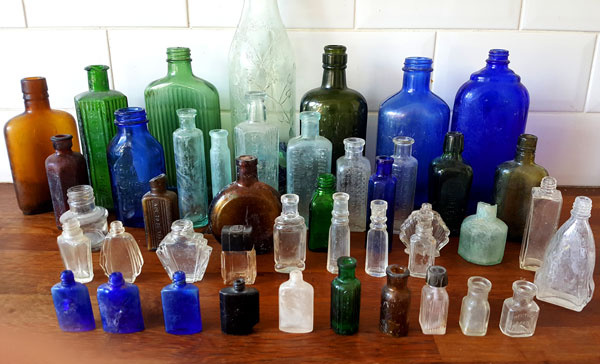
Mudlarking along the River Thames in London is a muddy, smelly, and treacherous adventure. For nearly 2,000 years, people have lived and worked along the river in Central London. In its heyday, the River Thames in London was the largest port in the world, bustling with activity on the water and along the riverfront.
For eleven continuous miles in London, both sides of the river were packed with docks, wharfs, warehouses, shipbuilding yards, ship-breaking yards, fish markets, factories, breweries, slaughter houses, municipal buildings, offices, pubs, houses, etc. The human, animal, and industrial waste from these facilities was dumped directly into the River Thames for hundreds of years.
Located in the heart of the city, the river was London’s garbage dump and open sewer. By the 19th century, the Thames had become the most contaminated and unhygienic river in the world. During the “Great Stink” in the summer heat wave of 1858, London was brought to its knees as the overwhelming smell from the untreated human waste and industrial effluent in the river became absolutely unbearable. Within the Houses of Parliament in Westminster, the front rooms adjacent to the river were closed and abandoned by politicians because of the nauseating smell.
The river became so polluted that it was declared “biologically dead” by the Natural History Museum in 1957. Fortunately, the cleanliness of the water has greatly improved in the last few decades, and now over 125 species of fish, eels, waterfowl, seals, and even seahorses have returned to live in the Thames.
Collecting the city’s waste for nearly 2,000 years, the River Thames is a great repository of discarded objects, especially glass. The dense, soft, anaerobic mud of the Thames encapsulates the bottles and protects many of them from breakage. As the foreshore is slowly being eroded away by the waves of passing boats, many historic glass bottles are revealed as the tide recedes; they are collected by mudlarks before the strong river current sweeps them away or smashes them on the rocks.
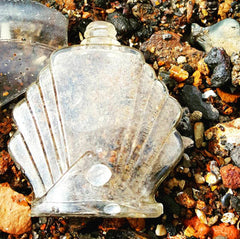 Over the last few years, Sarah Rook has found some incredible complete bottles (shown above) while mudlarking along the exposed riverbed. Searching primarily along the Thames Estuary east of London, Sarah has found a wide range of bottles from the 19th and early 20th centuries. Many of the bottles have text embossed into the surface of the glass, identifying the bottle’s maker, name of the shop for which it was made, and the bottle’s contents. Some of the vibrant blue and green bottles even say “NOT TO BE TAKEN” which indicates that they once contained poison. My favourite bottles which Sarah has found are the uniquely shaped perfume bottles from the early 20th century. These little, elegant gems display the creativity and fashions of the time period.
Over the last few years, Sarah Rook has found some incredible complete bottles (shown above) while mudlarking along the exposed riverbed. Searching primarily along the Thames Estuary east of London, Sarah has found a wide range of bottles from the 19th and early 20th centuries. Many of the bottles have text embossed into the surface of the glass, identifying the bottle’s maker, name of the shop for which it was made, and the bottle’s contents. Some of the vibrant blue and green bottles even say “NOT TO BE TAKEN” which indicates that they once contained poison. My favourite bottles which Sarah has found are the uniquely shaped perfume bottles from the early 20th century. These little, elegant gems display the creativity and fashions of the time period.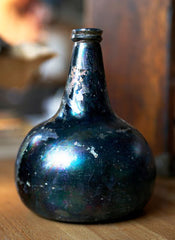 While mudlarking along the Thames in East London, Nick Stevens has spotted numerous pieces of broken 18th century “onion” bottles in one particular area. It is very rare to find an unbroken bottle of this type. Hoping to find a complete bottle, Nick returned to the spot on a very low tide. To his delight, he retrieved an unbroken onion bottle which was cushioned for centuries in the soft, dense mud. The unique, wide-bottom shape of the onion bottle was developed to prevent the bottle from tipping over and spilling its fine wine or spirits on ships sailing across stormy seas.
While mudlarking along the Thames in East London, Nick Stevens has spotted numerous pieces of broken 18th century “onion” bottles in one particular area. It is very rare to find an unbroken bottle of this type. Hoping to find a complete bottle, Nick returned to the spot on a very low tide. To his delight, he retrieved an unbroken onion bottle which was cushioned for centuries in the soft, dense mud. The unique, wide-bottom shape of the onion bottle was developed to prevent the bottle from tipping over and spilling its fine wine or spirits on ships sailing across stormy seas.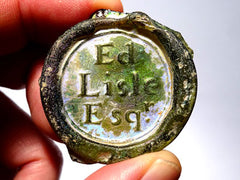 In London, some of the lowest tides occur late at night in July and August. Hoping to find older artefacts on stretches of the river bed which are only revealed once or twice a year, I strapped on my high-powered headlamp and went mudlarking in the dark. As I was crawling on my hands and knees along the exposed riverbed, I stumbled across a round glass object, illuminated by my headlamp. After rolling around at the bottom of the Thames for centuries, the bottle had been completed smashed, leaving only the thick, glass seal which had been attached to the side of the bottle. When I turned over the iridescent piece of glass, I was surprised to see the name “Ed Lisle Esqr” written on the early 18th century bottle seal. According to David Burton’s book, Antique Sealed Bottles 1640 -1900 and the Families that Owned Them, this bottle seal originates from Hampshire, England where Edward Lisle lived on a manor which he had inherited in 1693. Edward fathered 20 children (of which three died of small pox), and he wrote a book about agricultural and farming practices which was published after his death in 1722 and apparently became a bestseller at that time. From this humble 18th century bottle seal recovered from the River Thames, it has been possible to uncover intriguing backstories about Edward Lisle, who has been long forgotten.
In London, some of the lowest tides occur late at night in July and August. Hoping to find older artefacts on stretches of the river bed which are only revealed once or twice a year, I strapped on my high-powered headlamp and went mudlarking in the dark. As I was crawling on my hands and knees along the exposed riverbed, I stumbled across a round glass object, illuminated by my headlamp. After rolling around at the bottom of the Thames for centuries, the bottle had been completed smashed, leaving only the thick, glass seal which had been attached to the side of the bottle. When I turned over the iridescent piece of glass, I was surprised to see the name “Ed Lisle Esqr” written on the early 18th century bottle seal. According to David Burton’s book, Antique Sealed Bottles 1640 -1900 and the Families that Owned Them, this bottle seal originates from Hampshire, England where Edward Lisle lived on a manor which he had inherited in 1693. Edward fathered 20 children (of which three died of small pox), and he wrote a book about agricultural and farming practices which was published after his death in 1722 and apparently became a bestseller at that time. From this humble 18th century bottle seal recovered from the River Thames, it has been possible to uncover intriguing backstories about Edward Lisle, who has been long forgotten. 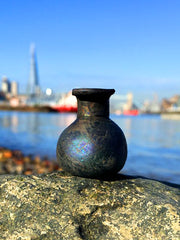 On a beautiful, sunny day in February 2018, I found an incredible 17th century apothecary bottle while mudlarking along the Thames foreshore. During the super low Spring tides in March 2018, Malcolm Russell found an 18th century medicinal bottle in extraordinary condition. It’s nothing short of a miracle that these fragile bottles have survived intact after centuries in the strong currents and turbulent tides of the river! Fortunately, the dense, thick mud of the River Thames has perfectly preserved these historical treasures. The pontil scar on the underside of the bottles indicates that they were blown freehand. Over the centuries, the colour of the glass has slowly become iridescent, exhibiting a rainbow of colours. The iridescent appearance is caused by alkali (soluble salt) being leached from the glass by the slightly acidic water of the River Thames.
On a beautiful, sunny day in February 2018, I found an incredible 17th century apothecary bottle while mudlarking along the Thames foreshore. During the super low Spring tides in March 2018, Malcolm Russell found an 18th century medicinal bottle in extraordinary condition. It’s nothing short of a miracle that these fragile bottles have survived intact after centuries in the strong currents and turbulent tides of the river! Fortunately, the dense, thick mud of the River Thames has perfectly preserved these historical treasures. The pontil scar on the underside of the bottles indicates that they were blown freehand. Over the centuries, the colour of the glass has slowly become iridescent, exhibiting a rainbow of colours. The iridescent appearance is caused by alkali (soluble salt) being leached from the glass by the slightly acidic water of the River Thames. 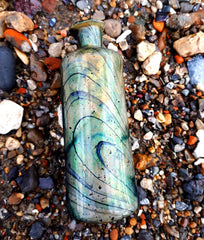 Fine layers of glass form and eventually separate slightly or flake off, causing a prism effect as light passes through the multiple layers of glass. As these bottles were found on the river bed below the historic docks, I can imagine that they could have been dropped from a ship, before or after a long journey on the open sea. These bottles were possibly a vital part of a sea surgeon’s medical supplies to treat ill sailors or those wounded in battles at sea. The glass bottles had to preserve the medicines and ingredients until they were needed during the weeks and months on a long voyage.
Fine layers of glass form and eventually separate slightly or flake off, causing a prism effect as light passes through the multiple layers of glass. As these bottles were found on the river bed below the historic docks, I can imagine that they could have been dropped from a ship, before or after a long journey on the open sea. These bottles were possibly a vital part of a sea surgeon’s medical supplies to treat ill sailors or those wounded in battles at sea. The glass bottles had to preserve the medicines and ingredients until they were needed during the weeks and months on a long voyage. 
Nicola White, a beachcomber from Cornwall, has been mudlarking for the last ten years along the River Thames, Thames Estuary and River Medway in South East England. Nicola is especially attracted to broken pieces of river glass which she collects for her artwork. “I am greatly inspired by the fact that each piece of glass I pick up has had a previous life and a history all of its own. I love to put these forgotten, once loved, or discarded fragments back together, and give them a new purpose in a piece of art,” Nicola explains. Her inspirations include Alfred Wallis, Guy Taplin, Margaret Mellis, and “all those who see beauty in something used and thrown away and can breathe new life into it!”
Some of Nicola’s most popular pieces of artwork are her famous glass fish. When I asked her why she uses the glass fragments to make fish, she explained that, “the glass has been in the river for so long, it seems only natural that they should be transformed into fish. When someone looks at one of my glass fish, I hope that they can see beyond the superficial nature of the artwork and let their imagination take them on a voyage – thinking about where each piece of glass has been before it ended up on the Thames foreshore, worn smooth by thousands upon thousands of tides. The colors and shapes of the glass also inspire me. In general, it is the textures, colors, and shapes which I find magical. I never really have a plan as to what a fish will look like. The creation process is very organic. It is almost as if they create themselves.”
Since she started her company, “Tideline Art,” Nicola has been creating collages and assemblages using other found items from the Thames foreshore, including driftwood, metal, glass, pottery, and plastic debris. Using her intuitive artistic talent, Nicola has carefully transforms discarded, broken materials into something beautiful. Expanding this concept, she is now working on a new, exciting project called “ArtReach” which encourages condemned prisoners to use creative expression to mentally escape from their present circumstances in the San Quentin State Prison in California.
Nicola explains the concept: “In the same way that I use items foraged from the beaches of the Thames to create collages and sculptures for Tideline Art, giving discarded objects a new purpose and a second chance as works of art; through ArtReach, I aim to bring those on the fringes of society into the limelight. The prisoners on death row have also been discarded and are considered of no use to society, thrown away, forgotten about, and I try to give them another chance, to show them that from a very dark place, some light can get out. ArtReach (reaching out with art and poetry from death row) was born out of the idea of offering these artists a platform to express themselves and to share their art – both online and through exhibitions.”
“The art and poetry are painted and penned in 10ft x 4ft x 7ft cells on death row in solitary confinement, and by exhibiting their work, I hope that it humanizes prisoners who have been sentenced to death, utilizing art as a vehicle to raise awareness, and to generate debate and discussion about capital punishment. They have developed their own styles, and in some cases, men use strands of their own hair or feathers as brushes. Tea, coffee, and even candy are sometimes used as paint. Any money made from sales is spent on art materials or at the canteen to supplement their diet. Over the past two years, ArtReach has put on seven exhibitions in the UK and one in California, not far from San Quentin.”
To find out more about Nicola’s artwork, visit her website at www.tidelineart.com.
To see the artwork of the San Quentin prisoners and learn more about the project, you can visit www.artofsanquentin.com.
Mudlarking on the Thames Foreshore requires a permit. Learn about rules for mudlarking in London ›
Learn more about bottles
Learn more about identifying bottles by shape and color, the history of bottle manufacturing, stoppers, marbles, and more. Articles ›
Learn more about mudlarking
Learn more about the experiences of mudlarks, who search the shores of rivers, bays, and seas for historical finds and other objects. Articles ›
This article appeared in the Glassing Magazine May/June 2018 issue.








